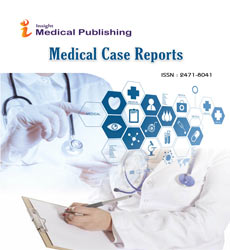A Rare Cause of Sepsis in a Patient with Chronic Kidney Disease-A Case Report
Sivaresmi Unnithan*
Sushmita Roy Chowdhury, Sivaresmi Unnithan* and Abhishek Koley
Department of Pulmonology and Respiratory Critical Care, Fortis Hospital, Anandapur, Kolkata
- *Corresponding Author:
- Sivaresmi Unnithan
Department of Pulmonology and Respiratory Critical Care, Fortis Hospital, Anandapur, Kolkata E-mail: sivaresmi@gmail.com
Received date: April 09, 2025, Manuscript No. IPMCRS-25-20333; Editor assigned date: April 11, 2025, Pre QC No. IPMCRS-25-20333 (PQ); Reviewed date: April 25, 2025, QC No. IPMCRS-25-20333; Revised date: May 02, 2025, Manuscript No. IPMCRS-25-20333 (R); Published date: May 09, 2025, DOI: 10.36648/2471-8041.11.02.407
Citation: Chowdhury SR, Unnithan S, Koley A (2025) A Rare Cause of Sepsis in a Patient with Chronic Kidney Disease-A Case Report. Med Case Rep Vol:11 No:2: 407.
Abstract
There are multiple microbial aetiological possibilities of sepsis with severe community acquired pneumonia in Chronic Kidney Disease patents with the outcome depending on host immune status and prompt relevant focused therapy. We report a fulminant case of sepsis who presented with features of meningitis and extensive cavitating pneumonia. Bronchoscopy revealed presence of Eschrechia coli and surprisingly Strongyloides stercoralis on wet mount BAL microscopic examination. The patient had presented in a very critical condition of refractory sepsis and meningitis with non-specific premonitory symptoms like fever, breathlessness and an episode of diarrhoea. Therefore, a high index of suspicion for parasitemia is suggested even in non-transplant patients of Chronic Kidney disease patients in refractory sepsis.
Keywords
Refractory sepsis; Chronic kidney disease; Strongyloides; cavitary consolidation
Introduction
There are multiple microbial aetiological possibilities of sepsis with severe community acquired pneumonia in a patient of chronic kidney disease. The outcome of the patient in severe sepsis depends on factors like the host immune status, polymicrobial co-infections including high index of suspicion of parasitic lung diseases and prompt relevant focused therapy. We report a fulminant case of sepsis who presented with features of meningitis and extensive pneumonia.
Case History
Our case is a 50-year-old hypertensive male recently diagnosed with chronic kidney disease who presented in the emergency room with high grade fever for four days, one episode of diarrhoea and progressive breathlessness for seven days. He was acidotic with high lactates, severe Type1 respiratory failure, and drowsy. He had to be mechanically ventilated and needed high dose of vasopressors His blood culture revealed E.coli within 48 hours.
His oxygenation was poor despite the sensitive antibiotics and his clinical condition was deteriorating rapidly. A Chest computed tomography revealed bilateral patchy consolidating infiltrates with a left upper lobe cavitating consolidation (Figure 1). This prompted us to do a bronchoscopy and the bronchoalveolar lavage revealed the same E.coli [105 cfu/ml] the next day. The same day we were surprised by a call from our microbiologist that a nematode could be seen on the BAL gram stain and it was identified as Strongyloides stercoralis. It was confirmed on the wet mount BAL microscopic examination (Figures 2,3).
Patient was immediately started on Ivermectin (given in the dose of 200 mcg/kg/day for 2 days). Unfortunately, the patient continued to deteriorate and succumbed to his disease on the fifth day of his hospital stay.
Discussion
S. stercoralis is essentially an intestinal nematode causing chronic asymptomatic infection and larval autoinfection (external-via perianal skin or internal-via intestinal wall penetration). This results in a much feared severe clinical entity called the hyperinfection and dissemination in mostly the immunocompromised patients who are undergoing steroid therapy or chemotherapy, and those with hematologic malignancy, hypogammaglobulinemia, kidney and bone marrow transplant, and HIV infection [1]. This condition is feared because dissemination has a very high mortality rate of up to 87% [2,3].
Other risk factors of hyperinfection has been cited such as chronic lung disease, age more than 65 years, altered cellular immunity, surgically created intestinal blind loops and achlorhydria [4].
Patients with chronic infection usually have eosinophilia. However, eosinophilia is often absent in hyperinfection and disseminated strongyloides infection as in our case [5].
Strongyloidiasis is not often suspected in a sepsis patient largely due to its nonspecific clinical signs, symptoms and radiology. Strongyloides can be detected by demonstration of larvae in the feces, duodenal fluid and wet preparation or Gram's stain of sputum samples and BAL. Usually, larvae in stool are demonstrated during active infection but may be absent in the larval migratory phase, as in our case where stool was negative for strongyloides larvae [4].
The lung is the most common extraintestinal organ involved in hyperinfection and its diagnosis requires a high index of suspicion [6].
Strongyloides hyperinfection in the lung spells two kinds of pulmonary complications. The dissemination due to migration of larvae from capillary beds into the alveoli produces inflammatory pneumonitis, and pulmonary hemorrhage which may show just fine miliary nodules or diffuse reticular infiltrates initially, progressing to patchy and diffuse lobar infiltrates finally culminating in ARDS [7].
Secondly, secondary microbial infection (fungal or bacterial) is quite common in pulmonary strongyloidosis which leads to increased mortality [8]. This occurs due to gut flora leakage from damaged intestinal mucosa as part of the disseminated disease and can also lead to fulminant sepsis and meningitis. Blood cultures commonly grow Escherichia coli, Klebsiella pneumoniae, Proteus mirabilis, Pseudomonas, and Enterococcus fecalis [9]. This probably explains the fulminant course of the disease in our patient.
Previously the treatment for simple pulmonary strongyloidiasis was thiabendazole 25 mg/kg orally twice a day for 2-3 days. The duration of therapy should be longer in hyperinfection syndrome. Now more effective agents include albendazole and ivermectin. Ivermectin is given in a dose of 200 mcg/kg/day for 1-2 days. Ivermectin should be repeated every 2-4 weeks in immunocompromised patients [1,4,7] and may be indefinite in disseminated infections and associated sepsis.
The prognosis of pulmonary strongyloidiasis depends on: host immune status, secondary bacterial infections and prompt and early diagnosis for institution of focused targeted therapy. Our case is unusual because detailed inquiry did not reveal any history related to the compromise of the immune system (corticosteroid therapy, immunosuppressive drug therapy, HIV/AIDS, malignancy etc.) except for the recently diagnosed hypertensive chronic kidney disease which was already in Stage 4 and probably in itself can be counted in as an immunocompromised condition for all practical purposes. Besides, the patient presented in a very critical condition of refractory sepsis and meningitis with nonspecific premonitory symptoms like fever, breathlessness and just one episode of diarrhoea. On further scrutiny with his family members, he did have dyspepsia issues often in the last 2 years which was being treated as Acid Peptic Disorder. To the best of our knowledge, there is no such article in the literature that reports any chronic kidney disease patient [not on steroids or dialysis and not a renal transplant receiver] presenting in such a severe clinical condition of disseminated strongyloidosis with E. coli co-sepsis.
S. stercoralis hyper infection and dissemination has been documented in immunocompetent patients in very few case reports [7,10].
A detailed literature review revealed that immunocompetent patients are not immune to hyper infection or dissemination syndromes, though. Most of them present with gastrointestinal symptoms and fever but they may also mimic acute exacerbation of underlying obstructive airways disease and be complicated with Gram-negative bacteremia [7].
Chan et al. [10] reviewed nine published cases of hyperinfection in immunocompetent patients and found male predominance with a median age of 48 years. Pulmonary complications ranged from lung abscess to ARDS in five cases, and three patients out of ten died (including the one reported by the authors).
Conclusion
Immunocompromised patients who present with an uncertain diagnosis but with clinical findings that may suggest the possibility of a parasitic lung disease, an early diagnostic bronchoscopy and lavage should be undertaken to rule out this fatal infection. Similarly, in immunocompetent patients especially those who present with a history of gastrointestinal symptoms or bowel handling should be worked up for parasitic lung diseases too, especially when they end up in such a critical condition as this.
Aggressive management in an intensive care unit including anthelmintic medication, mechanical ventilation and broadspectrum antibiotic early in the course of the disease may result in favorable outcome.
References
- Karuna T, Khadanga S (2014) A case of masquerading bronchopneumonia. Lung India 31: 161-163.
[Crossref] [Google Scholar] [Indexed]
- Igra-Siegman Y, Kapila R, Sen P, Kaminski ZC, Louria DB (1981) Syndrome of hyperinfection with Strongyloides stercoralis. Rev Infect Dis 3: 397-407.
[Crossref] [Google Scholar] [Indexed]
- Siddiqui AA, Berk SL (2001) Diagnosis of Strongyloides stercoralis infection. Clin Infect Dis 33: 1040–1047.
[Crossref] [Google Scholar] [Indexed]
- Chand T, Bansal A, Jasuja S, Sagar G (2016) Pulmonary strongyloidiasis and hyperinfection in a renal transplant patient. Lung India 33: 692-694.
[Crossref] [Google Scholar] [Indexed]
- Newberry AM, Williams DN, Stauffer WM, Boulware DR, Hendel-Paterson BR, et al. (2005) Strongyloides hyperinfection presenting as acute respiratory failure and Gram-negative sepsis. Chest 128:3681–4.
[Crossref] [Google Scholar] [Indexed ]
- Woodring JH, Halfhill H, Berger R, Reed JC, Moser N (1996) Clinical and imaging features of pulmonary strongyloidiasis. South Med J 89: 10–19.
[Crossref] [Google Scholar] [Indexed]
- Mohammed S, Bhatia P, Chhabra S, Gupta SK, Kumar R (2019) Pulmonary hyperinfection with Strongyloides stercoralis in an Immunocompetent Patient. Indian J Crit Care Med 23: 481-483.
[Crossref] [Google Scholar] [Indexed]
- Mani RK, Sardana R, Chawla R, Bansal A, Kanwar MS, et al. (2003) Respiratory failure, coma and cutaneous lesions due to disseminated strongyloidiasis. Indian J Crit Care Med 7: 132–6.
- Liu HC, Hsu JY, Chang KM (2009) Strongyloides stercoralis Hyperinfection presenting with symptoms mimicking acute exacerbation of chronic obstructive pulmonary disease. J Chin Med Assoc 72: 442–5.
[Crossref] [Google Scholar] [Indexed]
- Chan FLY, Kennedy B, Nelson R (2018) Fatal Strongyloides hyperinfection syndrome in an immunocompetent adult with review of the literature. Internal Medicine Journal 48: 872–875.
[Crossref] [Google Scholar] [Indexed]

Open Access Journals
- Aquaculture & Veterinary Science
- Chemistry & Chemical Sciences
- Clinical Sciences
- Engineering
- General Science
- Genetics & Molecular Biology
- Health Care & Nursing
- Immunology & Microbiology
- Materials Science
- Mathematics & Physics
- Medical Sciences
- Neurology & Psychiatry
- Oncology & Cancer Science
- Pharmaceutical Sciences



